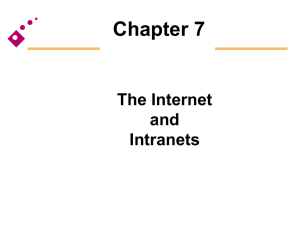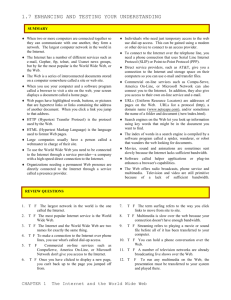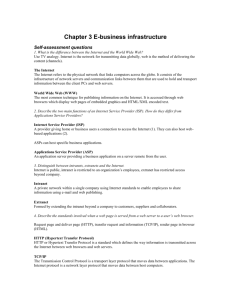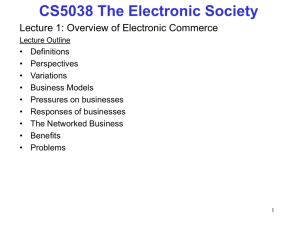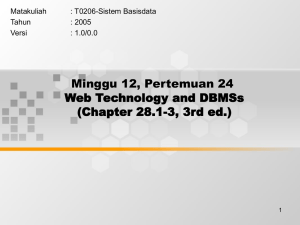9. the internet: electronic commerce, electronic business
advertisement
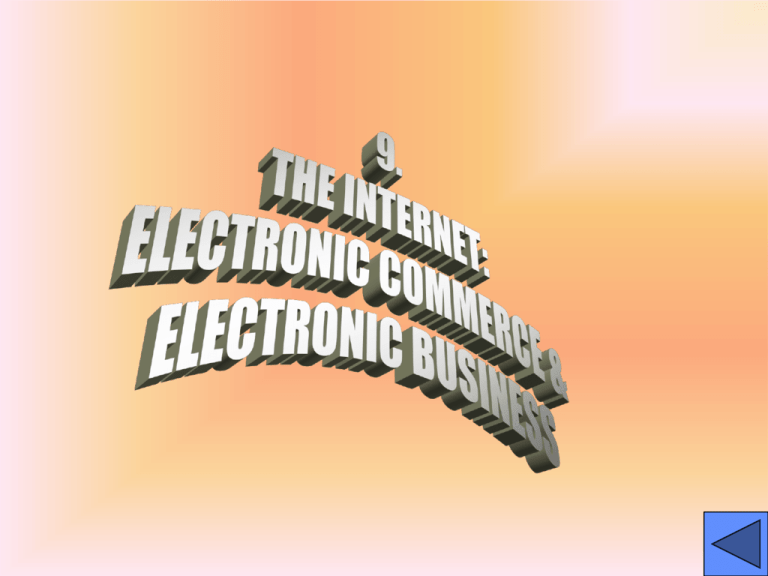
LEARNING OBJECTIVES • Describe Internet and its capabilities • Identify Internet benefits to organizations • Demonstrate how Internet used for Electronic Commerce (EC) * LEARNING OBJECTIVES • Demonstrate how Internet Technology used for Intra- and Interorganizational E-Business • Examine challenges of Internet to business & society * THE INTERNET • BEGAN AS GOVERNMENT CONNECTION OF UNIVERSITIES • INTERNET SERVICE PROVIDER (ISP): organization connected to Internet, leases temporary connections to subscribers • NO ONE OWNS IT, NO FORMAL ORGANIZATION * INTERNET CAPABILITIES • E -MAIL: person -to-person messaging; document sharing • USERNET NEWSGROUPS: electronic bulletin boards for discussion groups • LISTSERVs: e-mail list servers for discussion groups • CHATTING: interactive conversations • TELNET: log on one computer, work on another • FTP: transfer files from computer to computer • GOPHERS: use menus to locate text material * INTERNET CAPABILITIES • ARCHIE: search database for files to download • VERONICA: speeds searching gopher sites by using keywords • WIDE AREA INFORMATION SERVICE (WAIS): locates files using key words • WORLD WIDE WEB (Web): retrieve, format, display information (text, audio, graphics, video) using hypertext links * Internet Address ggalileo@univpisa.edu.it INDIVIDUAL OR ORGANIZATION NAME HOST COMPUTER DOMAIN LOCATION DOMAIN NAME Internet Address • IP Address: 147.222.29.54 Gonzaga University Jepson Center My laptop Internet Terms • Home Page: the default screen display welcomes user to organization’s page • Web Page: all other html pages • Webmaster: person in charge of Web site • Uniform Resource Locator (URL): address of specific Internet resource * Internet Terms • Hypertext Transport Protocol (http): communications standard used to transfer Web pages • Hypertext Markup Language (HTML): popular programming language for creating Web sites * SURFING THE NET • SEARCH ENGINE: tool for locating specific sites or information on WWW • “PUSH” TECHNOLOGY: server streams relevant content to browser • HYPERLINK: spot on screen, when clicked shifts to a new page or site * INTRANET • Internal Network • Use browser technology to overcome “platform” differences • FIREWALL: Security System to Prevent Invasion of Private Networks • Chmod 640? * EXTRANET ALLOWS SELECT USERS OUTSIDE ORGANIZATION TO USE ITS INTRANET: • CUSTOMERS • BUSINESS PARTNERS • VENDORS See Electronic Data Interchange, Chapter 8 * EXTRANET DATABASES CUSTOMER SUPPLIER INTERNET FIREWALL SERVER BUSINESS PARTNER CLIENTS EXTRANET • ATT Server to the World ambition • An office networked via phone line on the wall • Connect through ATT Central Computer • Low maintenance cost; no hassle Application Service Provider (ASP) • Rent instead of own • Someone else handles upgrading problems • Some applications are too expensive for one company to own (availability) • Technical support from ASPs (expertise) Internet & E-Commerce • EASY TO LINK WITH OTHER BUSINESSES, CUSTOMERS • CAN UPDATE PRODUCT INFORMATION, ORDERING, CUSTOMER SUPPORT • ON-LINE STOREFRONTS • ENHANCED BUSINESS FORMS * Internet & E-Commerce • CUSTOMER-CENTERED RETAILING – DISINTERMEDIATION: removal of intermediate layers streamlines process – REDUCED COST TO BUYER, SELLER * INTERNET BUSINESS MODELS • Virtual Storefront: sells goods, services on-line (Amazon.com) • Marketplace Concentrator: concentrates information from several providers (Portals) • Information Broker: provides product, pricing, availability information (E-bay) * INTERNET BUSINESS MODELS • Transaction Broker: buyers view rates, terms from various sources (Lendingtree.com) • Electronic Clearinghouse: auctionlike setting, products, prices, change in response to demand (E-bay) * INTERNET BUSINESS MODELS • Digital Product Delivery: sell, download software, other digital products • Content Provider: creates revenue through providing client for a fee, and advertising (www.wsj.com) • On-line Service Provider: provides service, support for hardware, software products * INTRANETS AND ELECTRONIC BUSINESS • ELECTRONIC COMMERCE SERVICES • BENEFITS • GROUP COLLABORATION • FUNCTIONAL APPLICATIONS • SUPPLY CHAIN MANAGEMENT * E-Commerce Services: • ICAT: on-line catalog shopping, order placement (Icat) • NET.COMMERCE: merchant server supporting Secure Electronic Transactions protocol (IBM) • MERCHANT SERVER: templates for storefronts, point-of-sales software (Microsoft) * E-Commerce Services: • MERCHANT SYSTEM: full set of retailing services (Netscape) • OM-TRANSACT: modular structure for payment schemes (Open Market) • PC-CHARGE: PC-based Web server credit card processing (Go Software) * SUPPLY-CHAIN MANAGEMENT CUSTOMERS MARKETING & SALES PRODUCTION PLANNING CUSTOMER SERVICE PROCUREMENT INTRANET ACCOUNTING & FINANCE SHIPPING & DISTRIBUTION INVENTORY PRODUCTION & MANUFACTURING CHALLENGES & OPPORTUNITIES • UNPROVEN BUSINESS MODELS • BUSINESS PROCESS CHANGE REQUIREMENTS • CHANNEL CONFLICTS • TECHNOLOGY HURDLES • LEGAL ISSUES • SECURITY & PRIVACY *



